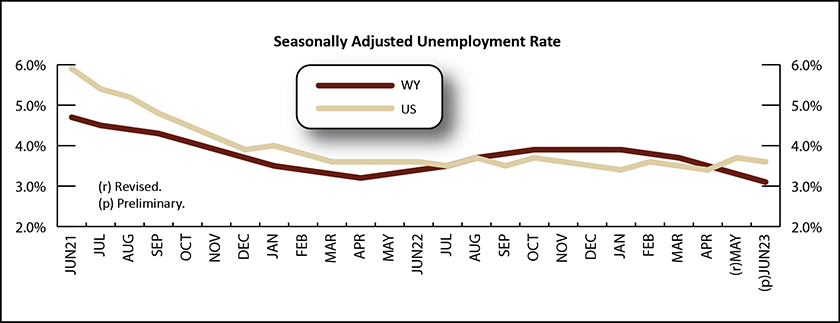Wyoming Labor Force Trends
August 2023 | Volume 60, No. 8
Click Here for PDF
Return to Table of Contents
Wyoming Unemployment Falls to 3.1% in June 2023
by: David Bullard, Senior Economist
The Research & Planning section of the Wyoming Department of Workforce Services reported that the state’s adjusted1 unemployment rate is slightly lower than its June 2022 level of 3.4% and lower than the current U.S. rate of 3.6%. From May to June, seasonally adjusted employment of Wyoming residents rose by 1,031 individuals (0.4%) as people went back to work.
At the county level, most unemployment rates increased slightly from May to June. It is not unusual for unemployment rates to increase in June as young people get out of school and start searching for work. The largest increases were seen in Albany (up from 2.4% to 3.1%), Uinta (up from 2.9% to 3.4%), Fremont (up from 3.1% to 3.5%), Goshen (up from 2.4% to 2.8%), Sublette (up from 3.0% to 3.4%), and Sweetwater (up from 3.2% to 3.6%) counties. Teton County’s unemployment rate fell from 2.8% in May to 1.7% in June as the summer tourist season got into full swing.
In June, jobless rates were lower than their year-ago levels in every county, suggesting that the state’s labor market is tightening. The largest decreases occurred in Lincoln (down from 4.3% to 2.9%), Big Horn (down from 4.2% to 3.2%), Platte (down from 3.5% to 2.6%), and Natrona (down from 4.1% to 3.2%) counties.
Teton County, at 1.7%, had the lowest unemployment rate in June. It was followed by Niobrara County at 2.0%, Weston County at 2.2%, and Crook County at 2.4%. The highest unemployment rates were found in Sweetwater County at 3.6% and Fremont County at 3.5%.
Total nonfarm employment in Wyoming (not seasonally adjusted and measured by place of work) rose from 290,900 in June 2022 to 300,900 in June 2023, an increase of 10,000 jobs (3.4%).
R&P's most recent monthly news release is available at https://doe.state.wy.us/LMI/news.htm.



.svg)
 Wyoming at Work
Wyoming at Work